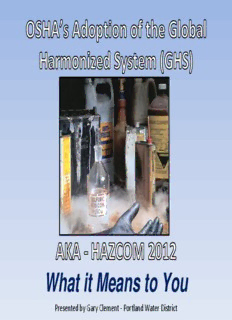
(GHS), AKA HAZCOM 2012: What it Means to You PDF
Preview (GHS), AKA HAZCOM 2012: What it Means to You
What it Means to You Presented by Gary Clemen t - Portland Water District Defining Terms • GHS – Global Harmonized System – U.N. sponsored, to improve safety information through a world wide compatible chemical classification, labeling, and safety sheets. • HCS - Hazard Communication Standard – OSHA’s “Right to Know” law. • HAZCOM 2012 – OSHA’ s updated HCS implementing GHS changes – “Right to Understand” A Review of the Hazard Communication Standard (HCS) • An OSHA Regulation • Adopted in 1983 • 43+ Million U.S. Workers • 5 Million Workplaces • Over 800,000 Chemicals • 2nd Most Cited Violation In 2012 Lack of training, labeling, access to MSDSs & lacking correct MSDS’s 4 Employer “Must Haves” Under HCS • Written hazard communication plan. • Written chemical inventory. • Proper use of labels and warnings. • Maintain MSDS’s. • Employee Training. 5 HCS Inconsistencies • Hazard communications regulations vary widely internationally • Classifications that address various end users vary within countries • No standard format for MSDS’s • Users often see different label warnings or MSDS’s for the same product. 6 The Basics of GHS • GHS = Globally Harmonized System of Classification and Labeling of Chemicals • U.N. Mandated in 1992 • Common & coherent global approach Definitions o Hazard Classifications o • Consistent communication on labels/safety data sheets • 67 Countries have adopted GHS. GHS Overview • GHS is Not... - A Regulation. • GHS is... - Framework or guidance for classifying and labeling hazardous chemicals -Adaptable by Country • Benefits - Estimated to prevent 500 injuries and 43 deaths per year Will GHS Make Life Better? - Estimated to prevent 500 injuries and 43 deaths per year - Costs per year will total $201 million dollars to comply with revisions to the HCS. - Future net benefits are estimated at $556 million dollars per year. The Three Major Changes 1. Chemical Hazard Classification 2. Labels 3. Safety Data Sheets (SDS’s) 10 Chemical Hazard Classifications 17
Description: